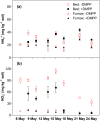Measurement and mitigation of nitrous oxide emissions from a high nitrogen input vegetable system
- PMID: 25644694
- PMCID: PMC4314647
- DOI: 10.1038/srep08208
Measurement and mitigation of nitrous oxide emissions from a high nitrogen input vegetable system
Abstract
The emission and mitigation of nitrous oxide (N2O) from high nitrogen (N) vegetable systems is not well understood. Nitrification inhibitors are widely used to decrease N2O emissions in many cropping systems. However, most N2O flux measurements and inhibitor impacts have been made with small chambers and have not been investigated at a paddock-scale using micrometeorological techniques. We quantified N2O fluxes over a four ha celery paddock using open-path Fourier Transform Infrared spectroscopy in conjunction with a backward Lagrangian stochastic model, in addition to using a closed chamber technique. The celery crop was grown on a sandy soil in southern Victoria, Australia. The emission of N2O was measured following the application of chicken manure and N fertilizer with and without the application of a nitrification inhibitor 3, 4-dimethyl pyrazole phosphate (DMPP). The two techniques consistently demonstrated that DMPP application reduced N2O emission by 37-44%, even though the N2O fluxes measured by a micrometeorological technique were more than 10 times higher than the small chamber measurements. The results suggest that nitrification inhibitors have the potential to mitigate N2O emission from intensive vegetable production systems, and that the national soil N2O emission inventory assessments and modelling predictions may vary with gas measurement techniques.
Figures


References
-
- Smith P. et al. in Climate Change 2007: Mitigation. Contribution of Working Group III to the Fourth Assessment Report of the Intergovernmental Panel on Climate Change (eds Metz B., et al.) 497–540 (Cambridge University Press, Cambridge and New York, 2007).
-
- Liu Q., Qin Y., Zou J., Guo Y. & Gao Z. Annual nitrous oxide emissions from open-air and greenhouse vegetable cropping systems in China. Plant Soil 370, 223–233 (2013).
-
- Di H. J. & Cameron K. C. Nitrate leaching in temperate agroecosystems: sources, factors and mitigating strategies. Nutr. Cycl. Agroecosyst. 46, 237–256 (2002).
-
- Chen D. et al. Prospects of improving efficiency of fertilizer nitrogen in Australian agriculture: a review of enhanced efficiency fertilizers. Aust. J. Soil Res. 46, 289–301 (2008).
-
- Akiyama H., Yan X. & Yagi K. Evaluation of effectiveness of enhanced-efficiency fertilizers as mitigation options for N2O and NO emissions from agricultural soils: meta-analysis. Glob. Change Biol. 16, 1837–1846 (2010).
Publication types
MeSH terms
Substances
LinkOut - more resources
Full Text Sources
Other Literature Sources

